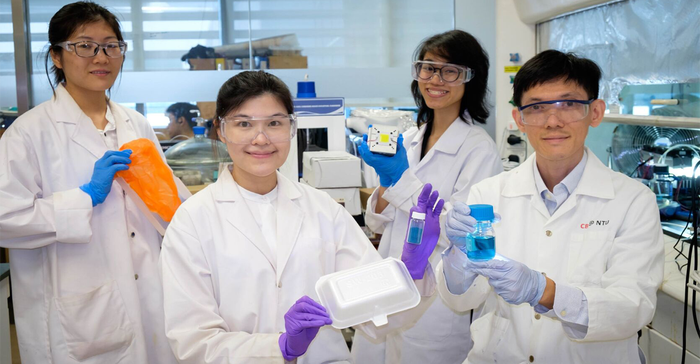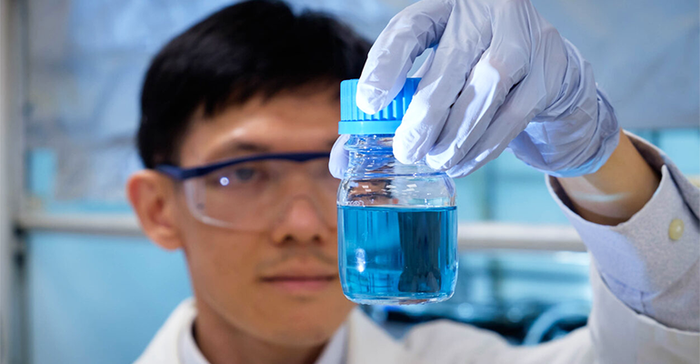How to Upcycle Plastics into Liquids That Store Energy
Researchers use LEDs to break down the inert carbon-carbon bonds in plastics with the help of a commercially available vanadium catalyst.
Researchers looking for an efficient way to upcycle waste plastics into something useful have seen the light.
Scientists from Nanyang Technological University, Singapore (NTU Singapore) have created a process that can upcycle most plastics into chemical ingredients useful for energy storage, using light-emitting diodes (LEDs) and a commercially available catalyst, all at room temperature.
The new process is highly energy efficient and can be easily powered by renewable energy in the future, unlike other heat-driven recycling processes like pyrolysis.
This innovation overcomes the current challenges in recycling plastics such as polypropylene (PP), polyethylene (PE) and polystyrene (PS), which are typically incinerated or discarded in landfills. Globally, only 9% of plastics are recycled, and the amount of plastic pollution is growing.
The biggest challenge of recycling these plastics is their inert carbon-carbon bonds, which require a significant amount of energy to break. This bond is also the reason why these plastics are resistant to many chemicals and have relatively high melting points.

From right: NTU Singapore Associate Professor Soo Han Sen, PhD student Chan Wei Xin, PhD Research Fellow Kong Xin Ying, and Lyu Maoping, PhD, hold various types of plastics, an LED lamp, the vanadium catalyst, and mixed plastic solution.
The researchers point out that the only commercial way to currently recycle such plastics is through pyrolysis. That method has high energy costs and generates large amounts of greenhouse emissions, making it cost-prohibitive given the lower value product of the resulting pyrolysis oil.
Developed by Associate Professor Soo Han Sen, an expert in photocatalysis from NTU's School of Chemistry, Chemical Engineering, and Biotechnology, the new method uses light-emitting diodes (LEDs) to activate and break down the inert carbon-carbon bonds in plastics with the help of a commercially available vanadium catalyst.
According to Brittanica, “vanadium is the 22nd most abundant element in Earth’s crust and is found combined in various minerals, coal, and petroleum.”
And according to Science Direct, “vanadium catalysts play an important role in the modern chemical industry and are used as special catalysts for sulfuric acid production, rubber synthesis, petroleum cracking, and synthesis of some high-molecular compounds.”
Published this week in the journal Chem, the NTU method can upcycle a range of plastics, including PP, PE and PS. Together, these plastics, together, account for more than 75% of plastic waste globally.
In developing a green solution to the plastic waste problem, the team wanted to ensure that minimal extra carbon emissions are generated through the recycling of plastics, which are long chains of molecules containing carbon atoms.
Inventor Assoc Prof Soo said: “Our breakthrough not only provides a potential answer to the growing plastic waste problem, but it also reuses the carbon trapped in these plastics instead of releasing it into the atmosphere as greenhouse gases through incineration.”

NTU Singapore Associate Professor and photocatalysis expert Soo Han Sen holds an energy-storing liquid made from mixed waste plastics.
Light-driven plastic upcycling process details.
First, the plastics are dissolved or dispersed in the organic solvent, dichloromethane, which is used to disperse the polymer chains so that they will be more accessible to the photocatalyst.
According to the American Chemical Society, the solvent is widely used in chemical research and manufacturing. It's highly volatile, but it is neither flammable nor explosive in air.
The solution is mixed with the catalyst then pumped through a series of transparent tubes where it's exposed to LED light.
The light provides the initial energy to break the carbon-carbon bonds in a two-step process with the help of the vanadium catalyst. The carbon-hydrogen bonds in the plastics are oxidized — making the bonds less stable and more reactive — after which the carbon-carbon bonds are broken down.
After separation from the solution, the resulting end products are chemical ingredients such as formic acid and benzoic acid, which can be used to make other chemicals employed in fuel cells and liquid organic hydrogen carriers (LOHCs). LOHCs are being explored by the energy sector as they play critical roles in clean energy development, given their ability to store and transport hydrogen gas more safely. LOHC shipping without heat recycling has an energy efficiency of 60-70%, according to Wikipedia.
Current and emerging technologies to recycle plastics often rely on pyrolysis, which is a high-temperature process to melt and degrade the plastics into low-quality fuels or carbon nanotubes and hydrogen. By contrast, the new LED-driven method requires much less energy.
Prof Soo adds that their method is unique in that it can use sunlight or LEDs powered with electricity from renewable sources such as solar, wind or geothermal, to completely process and upcycle such a wide range of plastics. This can allow for clean and energy-efficient management of plastics in a circular economy and increase the recycling rate of plastics.
The process may also help Singapore to reduce the amount of plastic waste from being incinerated or landfilled. That would help the country to meet its Zero-Waste Masterplan, which aims to increase the overall recycling rate to 70% by 2030 and reduce waste going to the Semakau landfill, which is estimated to run out of space by 2035.
Singapore generates around 1 million tonnes of plastic waste annually and only 6% of Singapore’s plastic waste is recycled.
The NTU team has filed a patent for their photocatalytic process, which has been designed with industrial scalability in mind, through the University’s innovation and enterprise company NTUitive. The team is now seeking partners to further commercialize the technology.
About the Author(s)
You May Also Like




